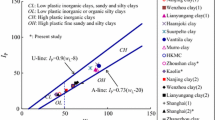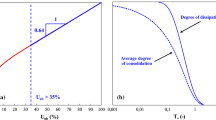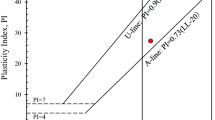Abstract
Creep or secondary consolidation of the clayey soil is critical and should be investigated. In this study, the creep behaviour of a clayey soil was investigated in the laboratory by conducting long-term oedometer tests. Standard loading and unloading procedures were followed to investigate creep for more than 1 year. The results confirmed the high creep potential of the clayey soil. Furthermore, the creep strain rate did not always increase with the load level because of the oedometric modulus hardening effect, which could be closely related to the rearrangement of the soil particles produced by secondary consolidation. A relationship existed between the compression index and the secondary consolidation coefficient, and their ratio was constant at approximately 0.026. The permeability approximately linearly increased with the void ratio. The difference in the creep behaviour at the same loading or unloading load levels indicated that the creep of the clayey soil was essentially stress-path dependent.










taken from the loading phase



Similar content being viewed by others
References
AFNOR (1995) Sols: reconnaissance et essais: essai de gonflement à l’oedomètre, détermination des déformations par chargement de plusieurs éprouvettes. XP P 94–091
AFNOR (2005) Geotechnical investigating and testing, Laboratory testing of soils, Part 5: incremental loading oedometer test. XP CEN ISO/TS 17892–5
Al Mukhtar M, Belanteur N, Tessier D, Vanapalli SK (1996) The fabric of a clay soil under controlled mechanical and hydraulic stress states. Appl Clay Sci 11:99–115
Baldi G, Hueckel T, Pellegrini R (1988) Thermal volume changes of the mineral-water system in low-porosity clay soils. Can Geotech J 25(4):807–825
Baldi G, Hueckel T, Peano A, Pellegrini R (1991) Developments in modeling of thermo-hydro-geomechanical behaviour of Boom clay and clay-based buffer materials. Final report EUR 13365 EN
Bennett RH, O’Brien NR, Hulbert MH (1991) Determinants of clay and shale microfabric signatures: processes and mechanisms. Microstructure of Fine-Grained Sediments. Springer, New York, pp 5–32
Bernier F, Volckaert G, Alonso E, Villar M (1997) Suction-controlled experiments on Boom clay. Eng Geol 47:325–338
Bernier F, Li XL, Bastiaens W (2007) Twenty-five years’ geotechnical observation and testing in the tertiary Boom Clay formation. Géotechnique 57(2):229–237
Berre T, Iversen K (1972) Oedometer test with different specimen heights on a clay exhibiting large secondary compression. Géotechnique 22(1):53–70
Bésuelle P, Viggiani G, Desrues J, Coll C, Charrier P (2014) A laboratory experimental study of the hydromechanical behavior of Boom clay. Rock Mech Rock Eng 47(1):143–155
Blanco LG, Romero E (2013) Laboratory investigation of gas transport processes in Boom Clay. Ph.D. collaboration agreement with ONDRAF/NIRAS (2013–2016). Annual report 1
Burland JB (1990) On the compressibility and shear strength of natural clays. Géotechnique 40(3):329–378
Casagrande A, Fadum RF (1940) Notes on soil testing for engineering purposes. Harvard Soil Mechanics, Series No. 8, Cambridge, Mass
Coelho PALF (2000) Geotechnical characterization of soft soils. Study of the experimental site of Quinta do Foja. M. Sc. dissertation, Univ. of Coimbra, Coimbra, Portugal (in Portuguese)
Coll C (2005) Endommagement des roches argileuses et perméabilité induite au voisinage d'ouvrages souterrains [Ph.D. thesis]. Grenoble: Université Joseph Fourier
Cotecchia F, Chandler RJ (2000) A general framework for the mechanical behaviour of clays. Géotechnique 50(4):431–447
Cuccovillo T, Coop MR (1999) On the mechanics of structured sands. Géotechnique 49(6):741–760
Cuccovillo T, Coop MR (1997) Yielding and prefailure behaviour of structured sands. Géotechnique 47(3):491–508
Cui YJ, Le TT, Tang AM, Delage P, Li XL (2009) Investigating the time-dependent behaviour of Boom clay under thermo-mechanical loading. Géotechnique 59(4):319–329
Dao LQ (2015) Etude du comportement anisotrope de l’argile de Boom. [Ph.D. thesis]. Paris: University Paris-Est
Decleer J, Viane W, Vandenberghe N (1983) Relationships between chemical, physical and mineralogical characteristics of the Rupelian Boom clay. Belgium Clay Miner 18(1):1–10
Dehandschutter B, Vandycke S, Sintubin M, Vandenberghe N, Gaviglio P, Sizun JP, Wouters L (2004) Microfabric of fractured Boom Clay at depth: a case study of brittle-ductile transitional clay behaviour. Appl Clay Sci 26:389–401
Delage P, Lefebvre G (1984) Study of the structure of a sensitive champlain clay and of its evolution during consolidation. Can Geotech J 21(1):21–35
Delage P, Le TT, Tang AM, Cui YJ, Li XL (2008) Suction effects in deep Boom Clay block samples. Géotechnique 57(1):239–244
Deng YF, Tang AM, Cui YJ, Nguyen XP, Li XL, Wouters L (2011) Laboratory hydro-mechanical characterisation of Boom Clay at Essen and Mol. Phys Chem Earth, Parts A/b/c 36(17–18):1878–1890
Deng YF, Cui YJ, Tang AM, Li XL, Sillen X (2012) An experimental study on the secondary deformation of Boom clay. Appl Clay Sci 59–60:19–25
Dizier A, Chen GJ, Li XL (2017). State of the art: thermo-hydro-mechanical behavior of the Boom Clay. Internal report of Euridice
Fabre G, Pellet F (2006) Creep and time-dependent damage in argillaceous rocks. Int J Rock Mech Min 43(6):950–960
Feng WQ, Lalit B, Yin ZY, Yin JH (2017) Long-term Non-linear creep and swelling behavior of Hong Kong marine deposits in oedometer condition. Comput Geotech 84:1–15
Fredlund DG, Rahardjo H (1993) Soil mechanics for unsaturated soils. Wiley, New York
Frederickx L, Honty M, De Craen M, Dohrmann R, Elsen J (2018) Relating the cation exchange properties of the Boom Clay (Belgium) to mineralogy and pore-water chemistry. Clays Clay Miner 66:449–465
Frederickx L, Honty M, De Craen M, Elsen J (2021) Evaluating the quantification of the clay mineralogy of the Rupelian Boom Clay in Belgium by a detailed study of size fractions. Appl Clay Sci 201:105954
Gao QF, Hattab M, Jrad M, Fleureau JM, Hicher PY (2020) Microstructural organisation of remoulded clays in relation with dilatancy/contractancy phenomena. Acta Geotech 15:223–243
Gens A (2012) Geomechanics of argillaceous rocks for nuclear waste disposal, in ‘International Post – TIMODAZ Workshop’, Mont Terri rock laboratory, Saint-Ursanne, Switzerland
Han J, Yin ZY, Dano C, Hicher PY (2020) Cyclic and creep combination effects on the long-term undrained behavior of overconsolidated clay. Acta Geotech. https://doi.org/10.1007/s11440-020-01078-5
Havel F (2004) Creep in soft soils. Ph. D thesis. Norwegian University of Science and Technology
Horseman ST, Winter MG, Entwisle DC (1986) Geotechnical characterization of Boom Clay in relation to the disposal of radioactive waste. British geological Survey, Keyworth, Nottingham, report
Kaddouri Z, Cuisinier O, Masrouri F (2018) Influence of effective stress and temperature on the creep behavior of a saturated compacted clayey soil. Geomechanics for Energy and the Environment. https://doi.org/10.1016/j.gete.2018.09.002
Le TT (2008) Comportement thermo-hydro-mécanique de l’argile de Boom [Ph.D. thesis]. Paris: Ecole Nationale des Ponts et Chaussées
Leroueil S, Vaughan PR (1990) The general and congruent effects of structure in natural soils and weak rocks. Géotechnique 40(3):467–488
Lima A (2011) Thermo-hydro-mechanical behaviour of two deep Belgian clay formations: Boom and Ypresian clays [Ph.D. thesis]. Spain: Universitat Politècnica de Catalunya
Maigre D, Tessier D, Grunberger D, Velde B, Vasseur G (1998) Evolution of microstructures and of macroscopic properties of some clays during experimental compaction. Mar Pet Geol 5:109–128
Mesri G, Castro A (1987) Cα/Cc concept and K0 during secondary compression. J Geotech Eng 113(3):230–247
Mesri G, Feng TW, Benak JM (1990) Post densification penetration resistance of clean sands. J Geotech Eng 116(7):1095–1115
Mesri G, Vardhanabhuti B (2005) Secondary Compression J Geotech Geoenviron Eng 131(3):398–401
Nguyen XP (2013) Étude du comportement chimico-hydromécanique des argiles raides dans le contexte du stockage de déchets radioactifs [Ph.D. thesis]. Paris: University Paris-Est
Olek BS (2020) Experimental insights into consolidation rates during one-dimensional loading with special reference to excess pore water pressure. Acta Geotech 15:3571–3591
ONDRAF/NIRAS (2001) Aperҫu technique du rapport SAFIR 2. Safety assessment and feasibility interim report 2. Publication NIROND 2001–05 F
Pusch R (1978) Creep mechanisms in clay. InProc. Interdiscip. Conf. Mech. Deformation and Fracture: 351–359
Richards NP, Barton ME (1999) The folkestone bed sands: microfabric and strength. Q J Eng Geol Hydroge 32(1):21–44
Robinson R (2003) A Study on the Beginning of Secondary Compression of Soils. J Test Eval 31(5):388-397
Robinson RG, Allam MM (1998) Effect of clay mineralogy on coefficient of consolidation. Clay Clay Miner 46(5):596–600
Schmertmann JH (1991) The mechanical aging of soils. J Geotech Eng 117(9):1288–1330
Sorensen KK, Baudet AB, Simpson B (2007) Influence of structure on the time-dependent behaviour of a stiff sedimentary clay. Géotechnique 57(1):113–124
Sposito G (1984) The surface chemistry of soils. Oxford University Press, New York
Suarez NR (2012) Micromechanical aspects of aging in granular soils. Ph. D theses, Blacksburg, VA
Taylor DW (1948) Fundamentals of soil mechanics. John Wiley and Sons, New York
Tavenas F, Leroueil S, La-Rochelle P, Roy M (1978) Creep behavior of an undisturbed lightly overconsolidated clay. Can Geotech J 15(3):402–423
TIMODAZ (2007) Deliverable 2. Thermal impact on the damage zone around a radioactive waste disposal in clay host rocks. European commission
Tremblay H, Duchesne J, Locat J, Leroueil S (2002) Influence of the nature of organic compounds on the fine soil stabilization with cement. Can Geotech J 39:535–546
Venda Oliveira PJ, Correia AAS, Garcia MT (2013) Effect of stress level and binder composition on secondary compression of an artificially stabilized soil. J Geotech Geoenviron 5:810–820
Wileveau Y, Bernier F (2008) Similarities in the hydromechanical response of Callovo-Oxfordian clay and Boom Clay during gallery excavation. Phys Chem Earth 33:S343–S349
Wood DM (1990) Soil behaviour and critical state soil mechanics. Cambridge Univ, Press
Yu HD, Chen WZ, Jia SP, Cao JJ, Li XL (2012) Experimental study on the hydro-mechanical behavior of Boom clay. Int J Rock Mech Min Sci 53:159–165
Yu HD, Chen WZ, Gong Z, Tan XJ, Ma YS, Li XL, Sillen X (2015) Creep behavior of Boom Clay. Int J Rock Mech Min 76:256–264
Yu HD, Chen WZ, Gong Z, Gong Z, Ma YS, Chen GJ, Li XL (2018) Influence of temperature on the hydro-mechanical behavior of Boom Clay. Int J Rock Mech Min Sci 108:189–197
Zeelmaekers E, Honty M, Derkowski A, Środoń J, De Craen M, Vandenberghe N, Adriaens R, Ufer K, Wouters L (2015) Qualitative and quantitative mineralogical composition of the Rupelian Boom Clay in Belgium. Clay Miner 50:249–272
Zhang CL (2015) Deformation of clay rock under THM conditions. Geomechanics and Tunnelling 8(5):426–435
Zhang CL, Rothfuchs T (2004) Experimental study of the hydro-mechanical behaviour of the Callovo-Oxfordian argillite. Appl Clay Sci 26:325–336
Zhao D, Gao QF, Hattab M, Hicher PY, Yin ZY (2020) Microstructural evolution of remolded clay related to creep. Transp Geotech 24:100367
Acknowledgements
The authors thank European Underground Research Infrastructure for disposal of nuclear waste in Clay Environment (EURIDICE) for collaborating on the long-term THM behaviour of Boom Clay and providing the clay cores. With the remaining cores, further investigation on the oedometric creep behaviour of Boom Clay was conducted. The authors heartily thank them for their support.
Funding
This research was funded by the National Natural Science Foundation of China (Grant No. 51979266, 51879258, 51991392), and Youth Innovation Promotion Association CAS.
Author information
Authors and Affiliations
Corresponding author
Ethics declarations
Conflict of interest
The authors declare that the aforementioned contents represent the author’s personal opinion only, not the opinion of any other organizations or individuals.
Rights and permissions
About this article
Cite this article
Yu, H., Lu, C., Chen, W. et al. An insight into the creep mechanisms of a clayey soil through long-term consolidation tests. Bull Eng Geol Environ 80, 9127–9139 (2021). https://doi.org/10.1007/s10064-021-02472-3
Received:
Accepted:
Published:
Issue Date:
DOI: https://doi.org/10.1007/s10064-021-02472-3




